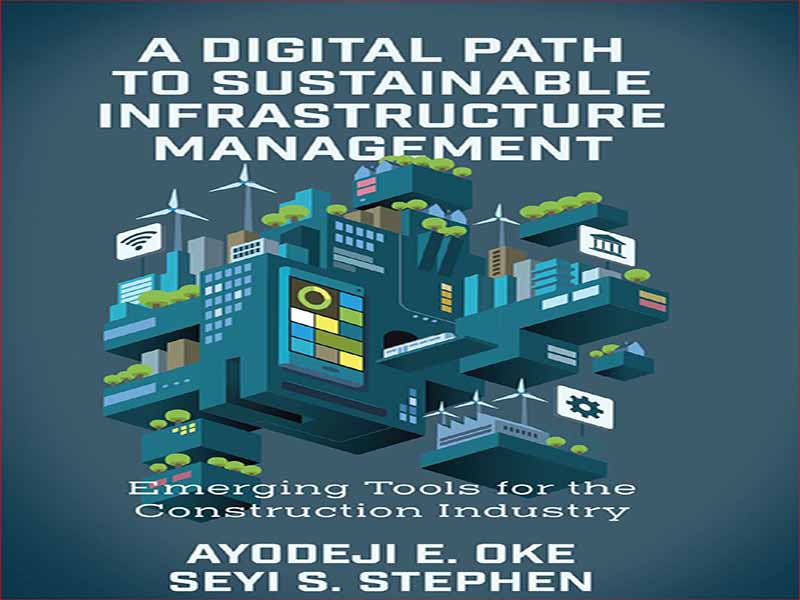- عنوان کتاب: A Digital Path to Sustainable Infrastructure Management
- نویسنده: Ayodeji E. Oke
- حوزه: مدیریت زیرساخت
- سال انتشار: 2024
- تعداد صفحه: 169
- زبان اصلی: انگلیسی
- نوع فایل: pdf
- حجم فایل: 3.31 مگابایت
صنعت ساختوساز در طول سالها فعالیتهای خود را از روشهای ابتدایی به روشهای پیشرفته در چندین مرحله ساختوساز (پیش از ساخت، ساخت و ساز و پس از ساخت) ارتقا داده است. از طریق اجرای چندین شیوه عملکردی، صنعت توانسته است به سمت ساخت و ساز حرکت کند که شامل استفاده از پیشرفت های دیجیتال (ساخت 4.0) در بهبود طراحی پروژه، اجرا و مدیریت پروژه های توسعه ای و زیرساختی است. با نوآوری ها در عصر انقلاب صنعتی چهارم (صنعت 4.0 عصر) تغییرات و انحرافات خاصی به وجود می آید. بنابراین، مدیریت این تفاوتها به بهترین روشها ضروری است، زیرا صنعت ساختوساز با توجه به شاخصهای سنتی (هزینه، کیفیت و مدت) و نوظهور تحویل پروژه، به اوج تحویل پروژه میپردازد. چندین روش مدیریتی در حال حاضر در ساخت و ساز وجود دارد مانند مدیریت ریسک، مدیریت ارزش، مدیریت ناب و مدیریت پروژه در میان سایر موارد که برای رفع کاستی هایی طراحی شده اند که ممکن است در ساخت و ساز صرف نظر از مرحله پروژه و همچنین روش اجرا رخ دهد. با این حال، با تغییرات مداوم در توسعه و رشد تجربه شده در صنعت ساخت و ساز در راستای پاسخگویی به خواسته های بی وقفه مشتری، و با توجه به تغییراتی که با شیوه های مدیریتی، به ویژه با پیشرفت های جدید تکنولوژیکی به وجود می آید، مهم است که در نظر بگیریم که چگونه این شیوه ها بر روند ساخت و ساز و نحوه مدیریت این اثرات در این عصر دیجیتال تأثیر می گذارد. مدیریت زیرساخت پایدار (SIM) مفهومی است که اصول پایداری را در طراحی، ساخت و مدیریت پروژههای زیرساختی با استفاده از چندین روش پایدار و فناوریهای دیجیتال اتخاذ میکند. با القای این شیوهها در مراحل ساخت و ساز، صنعت قرار است پتانسیل را از نظر مزایایی که با استفاده از فناوریهای دیجیتال در تحویل پروژه حاصل میشود، به حداکثر برساند. این کتاب در حالی که از چالشها، موانع و سایر ویژگیهای مرتبط در مورد کارکردهای آنها غافل نمیشود، برای کمک به خوانندگان با نظارت کلی بر شکافی که این فناوریها و شیوهها میتوانند از نظر افزودههایی برای ذینفعان و مشتریان پر کنند، طراحی شده است. از آنجایی که این کتاب برای جامعیت طراحی شده است، با مقدمه ای کلی از فصول و مطالب آن شروع می شود. این فصل ها با پر کردن شکاف دانش از نظر فرآیندها، کاربردها و اجراها، رابطه بین اتخاذ شیوه های پایدار و ساخت و ساز در عصر دیجیتال را به طور خلاصه توضیح می دهند. این کتاب “مسیری دیجیتال به سمت مدیریت زیرساخت پایدار” استفاده از ابزارها و فناوری های دیجیتال مانند ماشین های متصل، محاسبات شبکه، محاسبات ابری سیار، قرارداد هوشمند، محاسبات کوانتومی، محاسبات هوشمند، رادیو شناختی، فناوری سایبری، شناسایی فرکانس رادیویی را توضیح می دهد. RFID)، مکاترونیک و دوقلوهای دیجیتال برای تحویل پروژه های ساخت و ساز و توسعه. این کتاب می تواند به عنوان یک چارچوب تحقیقاتی توسط متخصصان در صنایع معماری، مهندسی، ساخت و ساز و بهره برداری (AECO) استفاده شود. بدون محدودیت، خوانندگان مورد انتظار این کتاب شامل متخصصان ساخت و ساز و مهندسی در زمینه های مختلف می شوند. دانشجویان کارشناسی و کارشناسی ارشد در رشته های ساختمانی و ساختمانی مرتبط با محیط زیست؛ ذینفعان و سیاست گذاران در صنعت معماری، مهندسی، ساخت و ساز و بهره برداری (AECO)؛ برنامه ریزان شهری و منطقه ای؛ افسران تدارکات در وزارتخانه ها (خصوصی و دولتی)؛ کارگران ساختمانی/علاقه مندان در کشورهای در حال توسعه و توسعه یافته؛ ذینفعان ساختمانی، عمرانی و صنعتی؛ مدیران پروژه؛ ارزش آفرینان در چندین زمینه؛ افرادی که دغدغه ساخت شهری هوشمند و پایدار دارند. و پیمانکاران ساختمان و پرسنل پروژه نظارتی در میان سایر خوانندگان.
The construction industry over the years has improved its activities from basic to advanced practices cutting across several construction stages (pre-construction, construction and post-construction). Through the implementation of several functional practices, the industry has been able to move towards construction that involves the application of digital advancements (construction 4.0) into enhancing project design, execution and management of developmental and infrastructural projects. With innovations in the current Fourth Industrial Revolution era (Industry 4.0 age) comes certain changes and deviations. It is, therefore, necessary to manage these differences in the best ways as the construction industry aims for the summit of project delivery with regards to traditional (cost, quality and duration) and emerging project delivery indices. There are several management practices already in place in construction such as risk management, value management, lean management and project management among others that are designed to cater for shortcomings that might occur in construction irrespective of the project phase as well as the method of execution. However, with constant changes in development and growth experienced in the construction industry as it works in line with meeting the incessant demands of the client, and considering modifications that come with management practices, especially with newly adopted technological advancements, it is important to consider how these practices will affect construction process and how these effects can be managed in this digital age. Sustainable infrastructural management (SIM) is a concept that adopts sustainability principles in the design, construction and management of infrastructural projects using several sustainable practices and digital technologies. By inculcating these practices into construction stages, the industry is set to maximise potential in terms of benefits that come with the application of digital technologies in project delivery. While not neglecting challenges, barriers and other related peculiarities about their functionalities, this book is designed to assist the readers with general oversight of the gap these technologies and practices can fill in terms of additions to both the stakeholders and the clients. Since this book is designed for comprehensiveness, it starts with a general introduction to the chapters and contents therein. Filling the knowledge gap in terms of processes, applications and executions, the chapters explain succinctly the relationship between the adoption of sustainable practices and construction in the digital age. This book ‘A Digital Path to Sustainable Infrastructure Management’ explained the usage of digital tools and technologies such as connected machines, grid computing, mobile cloud computing, smart contract, quantum computing, smart computing, cognitive radio, cyber technology, Radio Frequency Identification (RFID), mechatronics and digital twins for delivery of construction and developmental projects. This book can be used as a research framework by professionals in the architecture, engineering, construction and operation (AECO) industries. With no limitations, the expected readers of this book include construction and engineering professionals in various fields; undergraduate and postgraduate students in the construction and built environment-related disciplines; stakeholders and policymakers in the architecture, engineering, construction and operation (AECO) industry; urban and regional planners; procurement officers in ministries (private and public); construction workers/enthusiasts in both developing and developed countries; building, civil and industrial stakeholders; project managers; value creators across several fields; individuals concerned with building a smart and sustainable city; and building contractors and regulatory project personnel amongst other readers.
این کتاب را میتوانید از لینک زیر بصورت رایگان دانلود کنید:
Download: A Digital Path to Sustainable Infrastructure Management


































نظرات کاربران